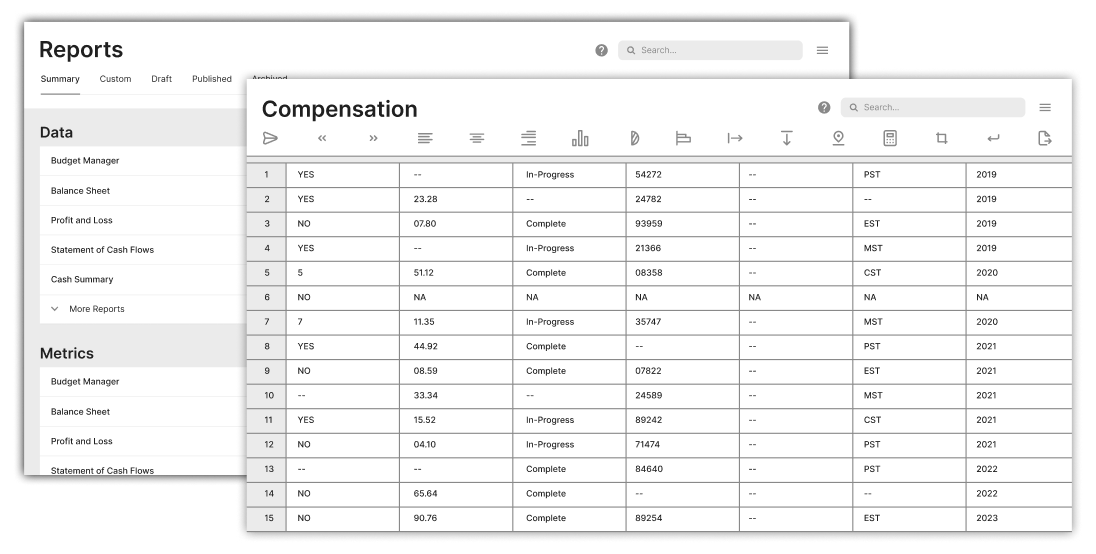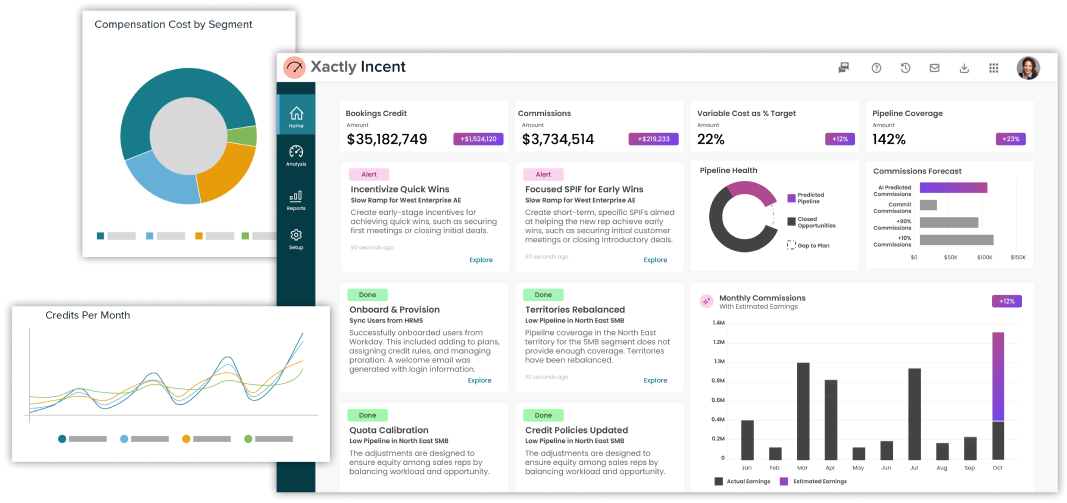Chapter 1
Why AI Alone Isn’t the Advantage
AI is only an advantage if your foundation is ready for it. Everyone wants the upside: faster decisions, leaner teams, and better financial outcomes. It’s the AI promise every vendor is selling—and every business leader is chasing.
But here’s the truth no one wants to hear: AI won’t fix what’s broken—it will expose it.
The Myth of AI as a Silver Bullet
AI is not a band-aid. It’s more like a spotlight. It doesn’t overlook bad inputs or flawed processes—it puts them in full view, almost instantly making every weakness impossible to ignore.
Bolting AI onto systems that weren’t built for it doesn’t create efficiency—it creates dysfunction at scale.
What AI Needs to Succeed
Before AI can elevate performance, it needs a solid foundation—one built on trustworthy data, structured and adaptable workflows, and goals rooted in strategy. Get the fundamentals right and then use AI to amplify what’s working, not to rescue what’s failing.
What’s Possible When the Foundation Is Ready
AI can do more than automate. It can transform.
The most powerful systems emerging today are agentic. They interpret and respond to changing conditions in real time—dynamically re-allocating territories, optimizing quotas, and redesigning incentive plans to keep growth targets realistic and reps motivated. They also flag remediation actions before forecasts slip, turning static processes into intelligent, closed-loop systems that keep both leaders and reps ahead of change.
What Exactly Is Agentic AI?
Most AI in sales is reactive — it waits for input, then generates an output. Agentic AI is proactive. It takes goals, context, and live data, then decides what to do next without needing step-by-step instructions.
In GTM, that might mean AI that spots an emerging market opportunity and reallocates territories before performance dips, personalizes offers instantly, or shifts resources toward high-probability deals—all without waiting for manual intervention.
Integrated systems
Aligned data
Efficient workflows
83%
of companies report payout inaccuracies, even though comp eats up ~10% of revenue.
— Xactly’s 2023 Compensation and Commission Accuracy Benchmark Report
That’s when AI becomes an advantage—not just another layer of complexity.
What’s Holding AI Back?
It’s not just the tech. And it’s not just the teams.
AI’s not equipped for GTM reality
Most AI solutions fall short because they weren’t designed for the realities of modern revenue teams.
- Trained on incomplete, theoretical, or siloed data
- Misaligned with how GTM teams actually operate
- Focused on automation—not autonomous optimization
Teams aren’t equipped for AI
Even the smartest tools underperform when structure, culture, and systems don’t support them.
- GTM teams lack integration and clean data flows
- Cultural resistance slows or blocks adoption
- Workflows are rigid and can’t evolve fast enough
The hype is real.
And so is the gap.
78%
of CFOs say AI will be a game-changer. But...
86%
say it hasn’t delivered significant value.
— Gartner, 2025 Leadership Vision for CFOs
6 Common AI Traps in Sales Performance
What Do You Actually Want AI to Do?
Before you ask “How do we use AI?” ask, “What do we want to improve?” Is it efficiency and speed? Accuracy and predictability? Rep performance or risk reduction?
Too often, teams race to deploy AI without aligning on outcomes. They treat AI like a strategy when what they really need is a clear problem to solve. The most successful GTM leaders align AI use cases to their company’s strategic goals. They give AI a mission, not just a mandate.
Why Is Everyone Still Chasing the Shiny Object?
Because the pressure is real.
Revenue leaders are under relentless scrutiny to grow faster, keep pace with constant change, and do more with less. In fact, Xactly’s own research shows that 87% of sales teams are struggling to hit quota targets, with over half saying external economic pressures are a major driver. That sense of urgency creates an appetite for fast solutions—and leaves the door wide open for vendors offering quick fixes. The buzzwords are everywhere: plug-and-play AI, out-of-the-box intelligence, automation that “just works.” But most of these aren’t genuine solutions—they’re slapped-on features that don’t scale, don’t adapt, and definitely don’t address real complexity.
Chapter 2
What an AI-Ready Revenue Engine Really Looks Like
An AI-ready revenue engine is powered by adaptable systems, clean data, and connected workflows that can handle constant market shifts and the complexity of modern go-to-market team structures. Engineered for real-world revenue realities, it turns change into an advantage rather than a setback.
Complexity Isn’t the Problem—It’s Your Advantage
Managing the revenue lifecycle will never be simple. It’s multi-threaded, nuanced, and always shifting. Top-performing GTM teams don’t fight complexity—they design for it. Their systems flex with change, connect the dots across functions, and scale without missing a beat. Because the real challenge isn’t complexity—it’s rigidity.
Scrambling Is Not a Strategy
When change hits, how fast can your team adjust?
If every market shift sends you into fire drill mode, rewriting sales compensation plans, redrawing territories, and rebuilding logic trees, you don’t have a strategy. You have survival tactics.
High-performing teams don’t panic. They pivot. They can reset quotas without eroding trust, rebalance territories before coverage gaps emerge, and adjust incentives so reps stay focused on strategy even when conditions change. That’s where AI creates real leverage. But AI can only move fast if your systems can.
Scaling AI Starts with Getting Your House in Order
AI doesn’t just automate. It learns—from every win, loss, and missed opportunity. Each insight feeds a smarter GTM engine that’s built to evolve. But for that to work, your foundation has to be solid. AI accelerates what’s working—and amplifies the cracks when it isn’t.
Integration Is the Next Advantage
Internal readiness is only half the story. The real unlock comes when AI in compensation doesn’t operate in isolation but connects across the wider tech stack. Hear what Dal Sidhu at Zoom has to say about this.
CHECKLIST
Before You Scale AI, Fix These Five First
Align your coverage model to your strategy
Make sure territories, quotas, and account ownership reflect the market opportunity and business goals.
Design your org for collaboration
Ensure the right roles are focused on the right things—RevOps, Sales, and Finance working together instead of in silos.
Translate priorities into AI use cases
Turn your revenue strategy into concrete AI applications that drive measurable performance.
Standardize your workflows across sales, RevOps, and support teams
AI can’t optimize what’s inconsistent or unclear. Consistent processes create the structure AI needs to work.
Clean and connect your GTM data
Bring together the data that describes what your GTM teams should be doing and what they’re actually doing. Without this, AI can’t guide or improve performance.
None of these are flashy. But all of them are absolutely essential. You don’t need to be bleeding-edge to be AI-ready. You need systems that work together, data you can trust, and leaders who are prepared to adapt. That’s the unfair advantage.
REALITY CHECK FOR CROs & CFOs
If your systems are out of sync, your AI will be too.
When your systems don’t talk, metrics conflict and manual workarounds pile up. AI doesn’t smooth that over—it sharpens the disconnect.
To get faster decisions, more confident forecasts, and revenue you can trust, you need:
Integrated systems
Aligned data
Efficient workflows
83%
of companies report payout inaccuracies, even though comp eats up ~10% of revenue.
— Xactly’s 2023 Compensation and Commission Accuracy Benchmark Report
That’s when AI becomes an advantage—not just another layer of complexity.
AI Wins Begin at the Top
Even the best tech won’t scale without cross-functional buy-in. AI changes how teams work together, how decisions are made, and who owns what. Success requires more than system readiness—it demands leadership alignment across:
Shared
Data
AlignedMetrics
Clear
Accountability
Plug-and-play won’t cut it. Change needs to be led, not just installed.
Chapter 3
When Insights Aren’t Enough
Everyone’s got dashboards. And KPIs. And endless trend lines. What most don’t have? A way to turn them into action. It’s not a reporting problem—it’s an execution problem.
Forecasting Is Failing. Here’s Why.
Sales forecasting methods haven’t kept up with today’s GTM reality. Economic volatility, shifting territories, quotas that no longer reflect reality, and evolving sales motions have all outpaced traditional dashboards and spreadsheets. Some teams have even scaled back forecasting, leaving planning to guesswork instead of grounded signals.
AI should offer more than agility. It should offer clarity—learning from real GTM performance, not just your history but patterns across teams, territories, and time. The best systems don’t just react. They anticipate. That’s the unfair advantage modern RevOps teams need.
Stuck in the past
Traditional Reporting
70%
of companies
still design their sales compensation plans in spreadsheets.
62% USE SPREADSHEETS AS ThEiR PRIMARY TOOL
9 in 10 of which contain errors.

Rearview mirror data
Static reports
Metrics for metrics’ sake
Manual interpretation
Generic Summaries
Recaps of what happened
Your Dashboard Doesn’t Care About Quota
A slick report won’t fix broken plans. If insights don’t connect to quotas, territories, or incentives, reps won’t trust them—and finance won’t bet the forecast on them. Dashboards that stop there are just telling you where you fell short.
Built to act
AI-Driven Execution Layer

Future-facing signals
Dynamic nudges
Recommendations that drive action
Real-time prioritization
Personalized insights by rep/territory
Guidance on what to do next
Insights Are Useless Without Structure
Most companies don’t lack data. They lack actionability. AI can surface all the insights in the world, but without context and structured workflows, they go nowhere. Bottom line? AI can’t drive revenue if your systems can’t drive action.
GTM teams without AI
Report
Review
Repeat
GTM teams with AI
Insight
Prioritize
Act
Chapter 4
Why Adoption Is a Leadership Problem
AI rarely fails because of tech. It fails because people don’t use it. No matter how advanced the algorithm, if teams don’t trust, understand, or integrate AI into their workflows, it won’t stick.
Clarity Converts Skeptics
Results alone aren’t enough — people need to see how AI works and why it matters.
Hear how Databricks envisions AI agents reshaping comp—moving from ticket requests to true transparency.
Transparency
builds confidence by making decisions visible.
Explainability
makes outcomes understandable and actionable.
AI isn’t the differentiator. Every company is looking at AI. The real differentiator is how ready your organization is to use it. And that’s more about leadership and culture than technology.”
— Arnab Mishra, CEO, Xactly
Most execs think AI’s edge is speed or cost savings. But real AI maturity isn’t just about doing things faster or cheaper. It’s about resilience: flexible systems, real-time adaptability, and readiness for what’s next.
Efficiency keeps you in the race. Resilience wins it.
Chapter 5
From Scrambling to Strategic
When sales compensation plans—or your incentive compensation management (ICM) process—are reactive, you’re always behind. With the right foundation, AI shifts you from firefighting to foresight.
Build Smarter Sales Compensation, Not Just Faster Fixes
Comp plans that keep changing create confusion, burnout, and revenue risk. AI helps you design for impact—not damage control.
Hear from Blue Horizon Group on how AI is helping companies move from scrambling to strategic in comp planning.
What’s Your Comp Mode?
Are You Guiding Performance—or Scrambling to Keep Up?
PANIC MODE
When your comp plans are built on reaction, you’re not managing performance—you’re putting out fires.
- Last-minute plan changes that signal strategy drift
- Reps chasing moving targets instead of strategic goals
- Manual overrides that erode system integrity and trust
- Exceptions that break fairness and forecasting
- Clawbacks that crush morale
These are patch jobs, not performance strategy.
PERFORMANCE MODE
When comp is designed to guide (not patch), you get:
- AI-driven prompts that guide behavior in real time
- Quotas that drive achievement and territories that maximize opportunity
- Incentives that tie directly to GTM growth priorities from day one
- Built-in flexibility that enables pivots without panic
- System trust that fuels rep confidence and performance
Strategic comp isn’t about payouts—it’s about predictable performance.
Build Plans That Build Performance
AI-powered modeling lets you test different incentive design and sales planning scenarios before rollout, reducing guesswork and giving teams time to course-correct before the quarter slips away.
ONLY
47%
OF COMPANIES automate plan changes
The rest are flying blind.
— Xactly’s 2024 Sales Compensation Report
Protip
Think of incentive design like product development:
Test
Measure
Iterate
AI-powered sales performance management solutions make it easier for you to:
Simulate outcomes before plans launch
Optimize quotas and coverage so reps aren’t chasing moving targets
Track impact in real time
Gamify behavior shifts to keep momentum high
The result?
Sales stays motivated
RevOps stays in control
Finance gets fewer surprises, stronger forecasts, and better capital efficiency
When you know the plan and you know it works, you’re not just hoping for results—you’re engineering them
CFO INSIGHT
Delaying ICM modernization costs more than you think.
Revenue resilience comes from systems that scale with change. Waiting to modernize compensation models or forecasting workflows doesn’t save money—it just shifts the cost to firefighting, misaligned incentives, and missed targets.
Chapter 6
What the Top 10% Get Right
Everyone’s adding AI. Only a few are making it matter. The companies seeing real results aren’t the ones chasing hype—they’re the ones treating AI as a performance engine, not a side project.
Proof That It Works
Even as CFOs question AI’s value, sales teams show the difference comes down to how it’s put into action.
83%
of sales teams using AI reported revenue growth—compared to just 66% of those without it. The gap isn’t the tech. It’s the approach.
— State of Sales industry report, 2024
With AI
83%
Without AI
66%
How the Best Are Winning with AI
Architecture Matters More Than You Think
AI is only as effective as the platform it runs on. When it’s built in, it has direct access to the structured, real-time operational data that drives sales performance. That means faster insights, smarter decisions, and outcomes that keep getting better.
Bolted-on AI creates lag, erodes trust, and misses the moment for action.
Built-in AI creates real-time feedback loops that move at the speed of sales—and a system that evolves with your strategy, not against it.
Everyone’s Adding AI. Few Are Building for GTM.
Training a model is easy. Applying it to the real-world complexity of selling, forecasting, and incentivizing? That’s the hard part. Most vendors can build AI. Very few can turn it into go-to-market performance. AI expertise is table stakes. Go-to-market fluency is the real advantage.
7
Essentials of a Modern Sales Performance Management (SPM) Partner
Most teams have already embraced AI for specific tasks, but the real opportunity is about rethinking the entire operating model. RevOps leaders who get ahead are the ones connecting the dots across compensation, forecasting, and resource allocation—because that’s where performance breakthroughs happen.”
— Chris Li, VP of Product, Xactly
5
Questions TO ASK
Before You ‘Do AI’
AI isn’t magic—it’s leverage. But it only works when strategy, data, workflows, and culture are ready. Before you move forward, pressure-test your plan with these 5 questions:
1.
What GTM problem are we solving?
It’s not “we need AI”—it’s “we need to fix something.” Start with the pain point.
2.
Is our compensation data clean, current, and connected?
Because AI is only as smart as the inputs.
3.
Can our workflows act on AI outputs?
Insights are pointless if they can’t trigger decisions.
4.
Will this scale beyond a pilot?
Consider extensibility, governance, and long-term support.
5.
Are we ready—organizationally and culturally?
Success requires aligned teams, empowered users, and an appetite to evolve.
Looking Back, Leading Forward
Top RevOps leaders aren’t chasing hype—they’re rewriting the playbook. Here’s what they’d prioritize if they were starting fresh with AI-driven performance in mind.
"I’d stop settling for AI that just observes. I’d look for systems that act.”
"I’d start by making incentive strategy part of our forecasting—not something we fix after the fact.”
"I’d bake GTM behavior into our models from day one. That’s how you drive real results.”
Chapter 7
The Real Advantage? Being Ready for What’s Next.
Top performers aren’t just reacting faster. They’re building systems that adapt faster. They adjust commissions, coverage, and capacity in real time to avoid missed targets and reduce costly course corrections.
GTM Isn’t Just Changing—It’s Accelerating
Buying cycles are faster, messier, and harder to predict. When plans can’t keep up, performance slips. Teams need to adapt compensation, territories, and targets in real time—not after the quarter’s already gone.
Forecasting is just one symptom: so are comp complexity, tool sprawl, platform rigidity, and talent churn. These aren't isolated problems; they’re signs that your GTM system is being outpaced by change.
In a market that won’t slow down, static strategies aren’t just outdated—they’re liabilities. Agility is the new advantage.
THE NEXT ADVANTAGE
The Future of GTM Is Hybrid
The most effective go-to-market teams aren’t going fully human or fully automated—they’re doing both. In this hybrid era, intelligence isn’t centralized; it’s distributed across people, platforms, and processes. The winners won’t replace reps—they’ll augment them with smarter systems that amplify what humans do best.
But for human-AI collaboration to actually drive speed, personalization, and performance, your compensation structures, planning, and forecasting need to evolve together. That’s the next advantage: not just having AI, but building the systems that let it work.
The unfair advantage isn't just AI. It's an agentic operating model that unites forecasting, compensation, and performance strategy, helping RevOps leaders move beyond efficiency to lead the next GTM era."
— Chris Li, VP of Product, Xactly
The Edge You Can’t Afford to Postpone
There’s more to AI than you think. AI’s real potential isn’t just doing more—it’s losing less when conditions change. Turn complexity into an edge and disruption into opportunity, and you’ll adapt faster, anticipate better, and pivot more strategically. The unfair advantage isn’t a feature—it’s a new way of operating. That’s what it takes to lead the next era of GTM with AI.
MORE WAYS TO PUT AI TO WORK
PLAYBOOK
Now Put AI Into Action
Download 5 practical ways to operationalize AI in sales performance management.
Get the playbook
AI HUB
Your next stop: the AI Hub
Browse exec perspectives, practical tools, and deeper insights.
Explore more















